Catan is one of the most iconic board games of all time, and the number of spin-offs that are available attest to its enduring popularity. One of these spin-offs – in fact, one of the best, in my opinion – is Catan Settlers of America.
Why do I think this version of the classic game is so good? First, it epitomizes exactly why Catan found so much success in the first place, not only in America but across the world: it taps into that ever-present urge of human nature to build, to travel, and to improve. And what better era to demonstrate this urge than 19th century America?
In Catan Settlers of America, you can relive this historical period by recreating the rapid expansion that early American pioneers achieved by traveling across the country and building a vital infrastructure of railroads.
But the best part is undoubtedly that your role in the foundation of America as we know it doesn’t start and end with railways. You are also able to move settlers across the map, creating cities and settlements.
Continue reading this Catan Settlers of America guide to find out more about the game, including its origins and how to play!
Catan Settlers of America: an Overview
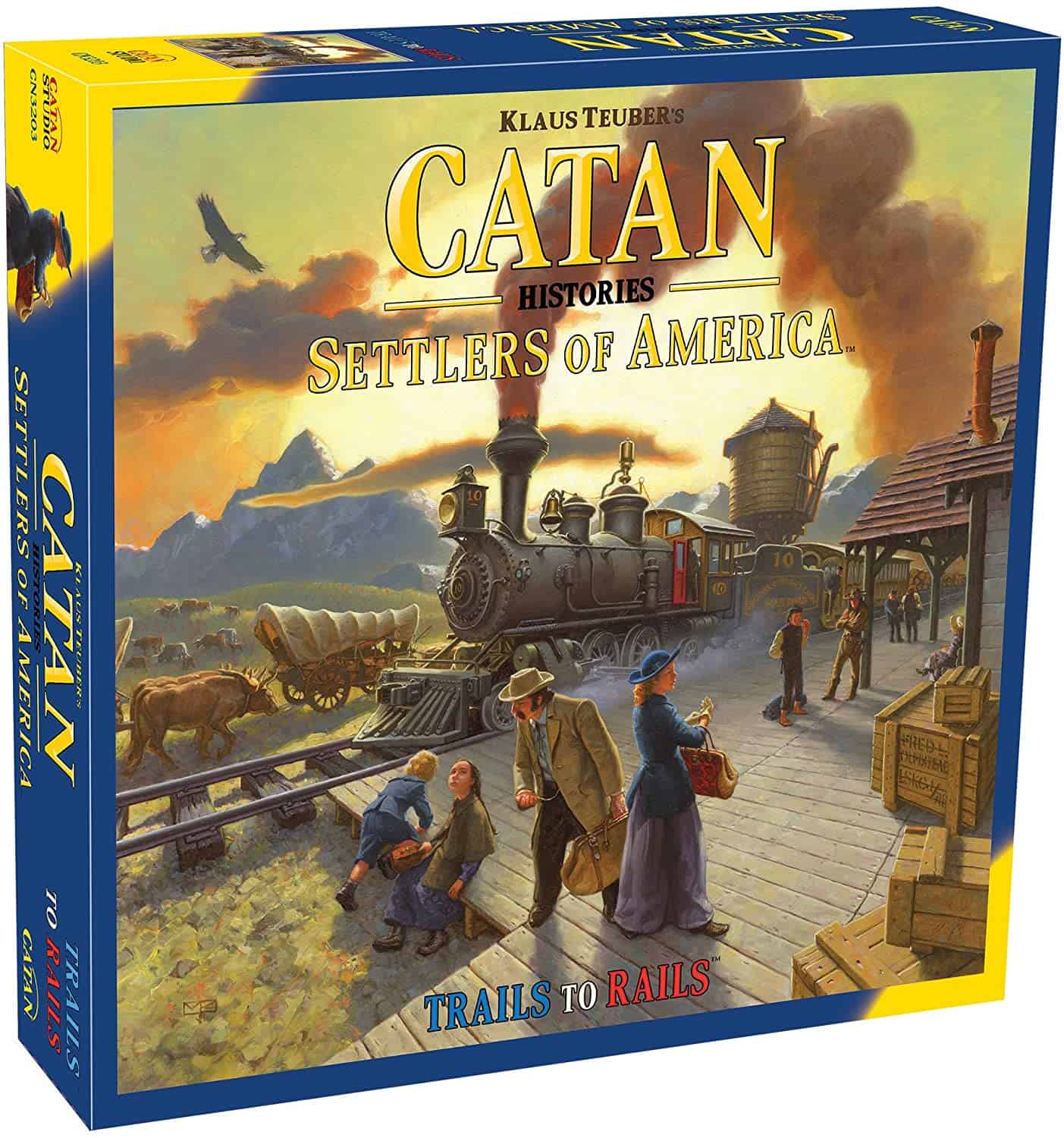
- Players – 3-4
- Recommended age – 12+
- Playing time – 120 minutes
The original version of Catan – previously known as Settlers of Catan – first came out in 1995 and has since been met by wide critical acclaim, making it a firm favorite board game for many people across the globe. You can read more about the original version in our Catan board game guide.
Fifteen years and many spin-offs later, Settlers of America arrived in 2010 as part of the Catan Histories line (also including Struggle for Rome and Settlers of the Stone Age). Like the original, it’s published primarily by Mayfair Games and designed by Klaus Teuber.
There are a number of other similarities shared between the original Catan and Settlers of America, not least of which is the familiar hex-tile grid that’s used on the board to divide areas of land.
It’s no surprise that, like many other editions of Catan, Settlers of America has garnered numerous awards, including “Best Historical Board Game” winner at the 2010 Origins Awards.
In the game, players must look to the west to accumulate their fortunes, collecting and trading resources so that they can:
- Purchase, migrate, and build settlements
- Acquire trains and build railroads
The more western settlements are established, the fewer resources will be available; to win the game, you’ll need to play carefully.
The greatest strength of Catan Settlers of America is, in my opinion, that it can function as both a fun game and also a US history lesson of sorts. Plus, it appeals to fans of train-themed games such as the immensely popular Ticket to Ride.
Next, let’s take a closer look at how this game can also be a history lesson for anyone willing to learn.
The History Behind Settlers of America
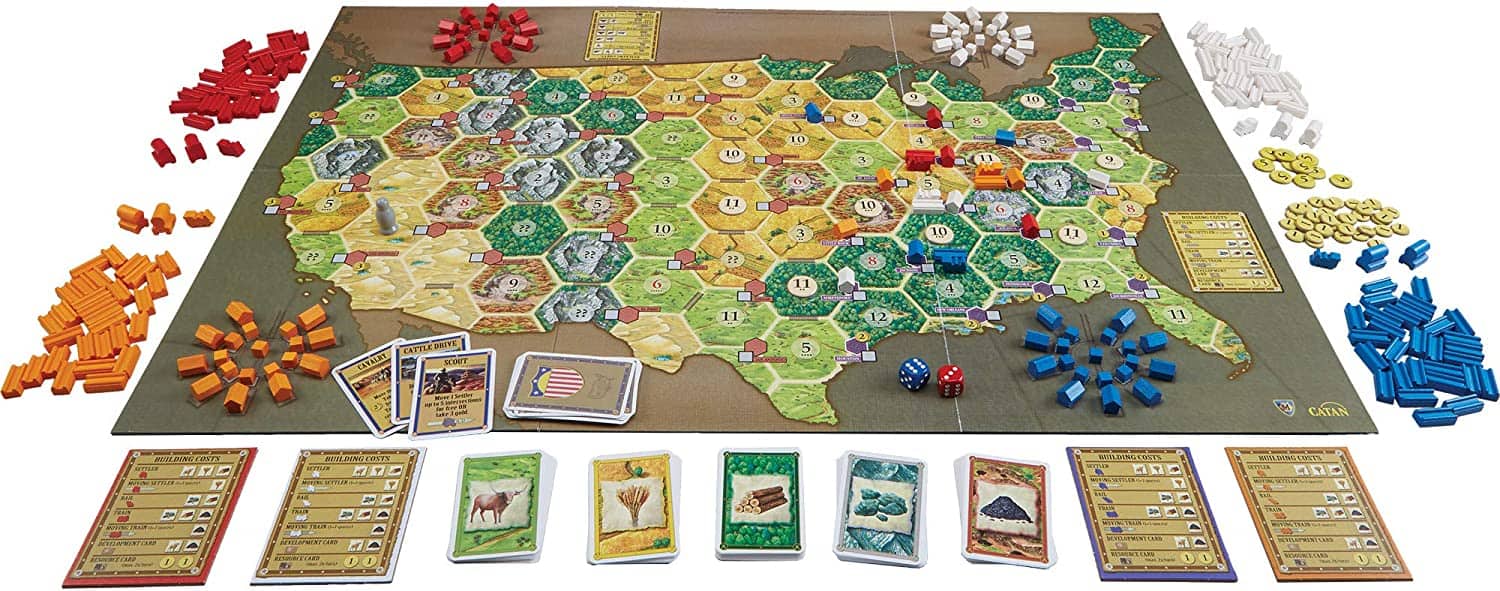
The 19th century in America is characterized by tremendous growth. It’s a period of US history in which many things were changing rapidly, particularly due to the transition from a farming economy to an industrial one.
As the population expanded west, native peoples were displaced on a profound scale, and civil war erupted while technology and transportation advanced rapidly. This was certainly a turbulent period in the history of the US.
So, how does Catan Settlers of America teach its players about 19th century America, I hear you ask? Other than highlighting just how crucial expansion and technological advancement were, the game also offers insight into what was most important at this time.
The resources in the game, for example, reflect the things that truly mattered to people: grains, cattle, coal, and lumber, to name but a few.
There is one area where the game’s sense of history is notably lacking – the only reference to Native Americans comes in the form of a “Native Support” development card – but to criticize it too heavily for this omission would be to forget that Settlers of America is, at its heart, a game that’s designed for entertainment, not a comprehensive history lesson.
How to Play
Before I explain the rules, there are a few things you should know about the map:
- It shows the continental US within its present-day boundaries
- Hexagons, also known as terrain hexes, depict different types of terrain, such as fields, hills, and pastures
- Each type of terrain produces a different type of resource
- The point where three terrain hexes meet is called an intersection; you move your settlers from one intersection to another
- An edge where two terrain hexes meet is called a path; your trains move along these
- Small hexagons called city sites to occupy certain intersections
- When one of your settlers stops on a city site, you have to settle and build a city there
Setup
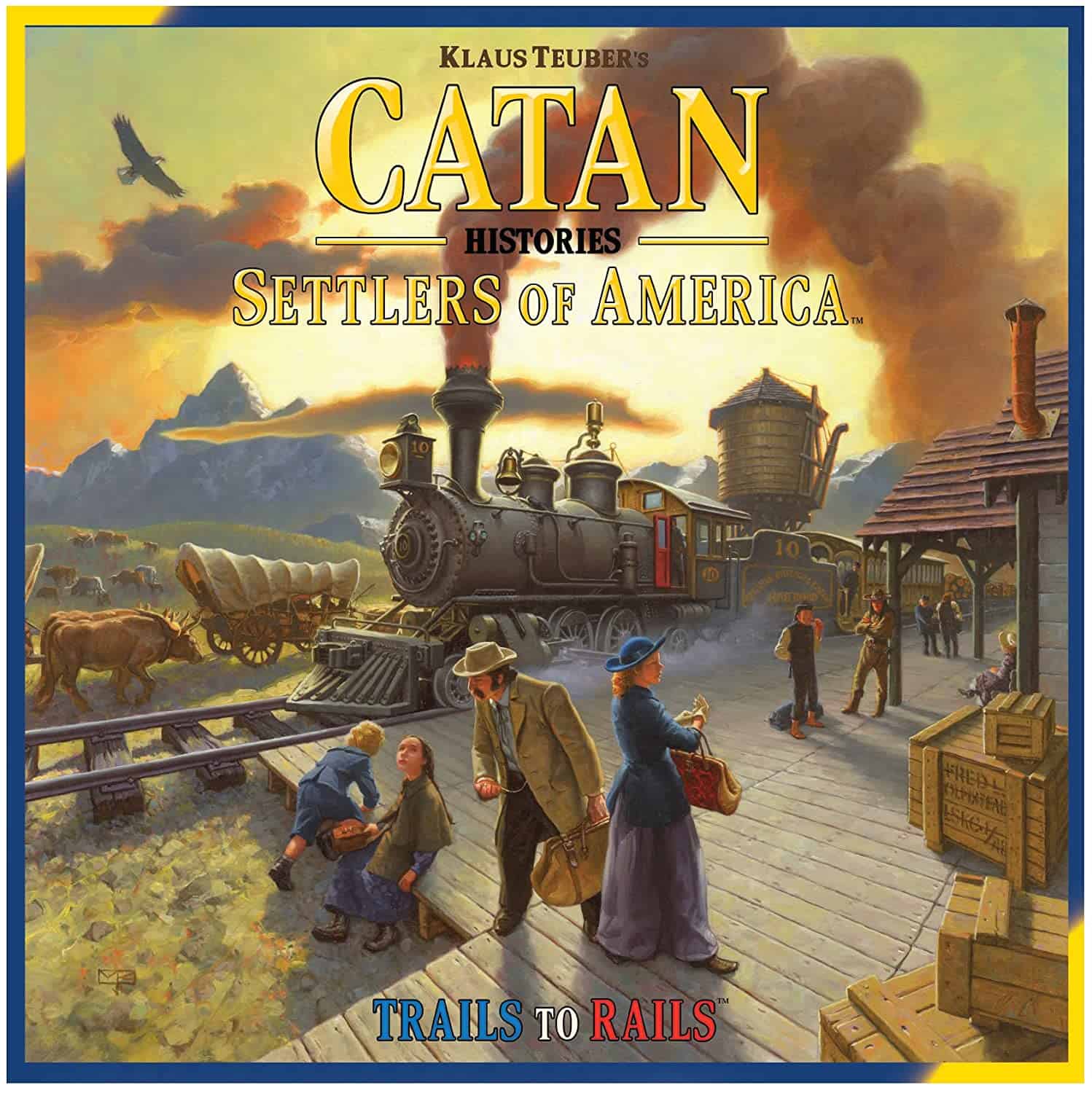
Here’s how to set the game up:
- Each player selects a color and takes the corresponding building cost card and game pieces (30 rails; 12 cities in a three-player game, 10 in a four-player game; 2 trains; 2 settlers; 10 goods in a three-player game, 8 in a four-player game)
- Place the 12 number tokens on the terrain hexes with the single question marks
- Shuffle the development cards and place the stack face down in the correct position on the board
- Sort the resource cards and place the resulting five stacks face up beside the board
- Place your starting pieces according to the illustration in the instruction booklet
- Place the gray outlaw piece on one of the desert hexes
- Take 3 gold tokens
- Place your goods cubes and remaining cities on one of the turntables on the board
- Place one goods piece in the center of the turntable and the rest in the square spaces next to your city pieces
For the first few games you play, you should begin with three resource cards as follows:
- Red player – 1 coal, 2 grain
- White player – 1 cattle, 1 grain, 1 ore
- Orange player – 1 cattle, 1 coal, 1 grain
- Blue player – 3 grain
Starting the Game
To begin, each player rolls the dice. Whoever rolls the highest number takes the first turn. Play continues clockwise until the game ends.
Production Phase
Roll the dice. If the sum of the numbers is seven, you move the outlaw; if it’s not a seven, terrain hexes produce resources for all players.
Rolling a seven means:
- Each player with more than seven resource cards must select half of them (round down) and return them to the supply
- The player who rolled the seven moves the outlaw onto any other numbered terrain hex
- The same player then steals one resource card from an opponent who has a city which is adjacent to the hex occupied by the outlaw
Not rolling a seven means:
- For each city adjacent to a terrain hex with the same number that was rolled, the player who owns that city takes a resource card corresponding to the type of resource produced by this terrain
- If the number of a terrain hex occupied by the outlaw is rolled, the owners of adjacent cities don’t receive resources
- If there aren’t enough cards of a given resource, no one receives any of that type of resource during the turn
- If you don’t receive any resources, take one gold token as compensation
Action Phase
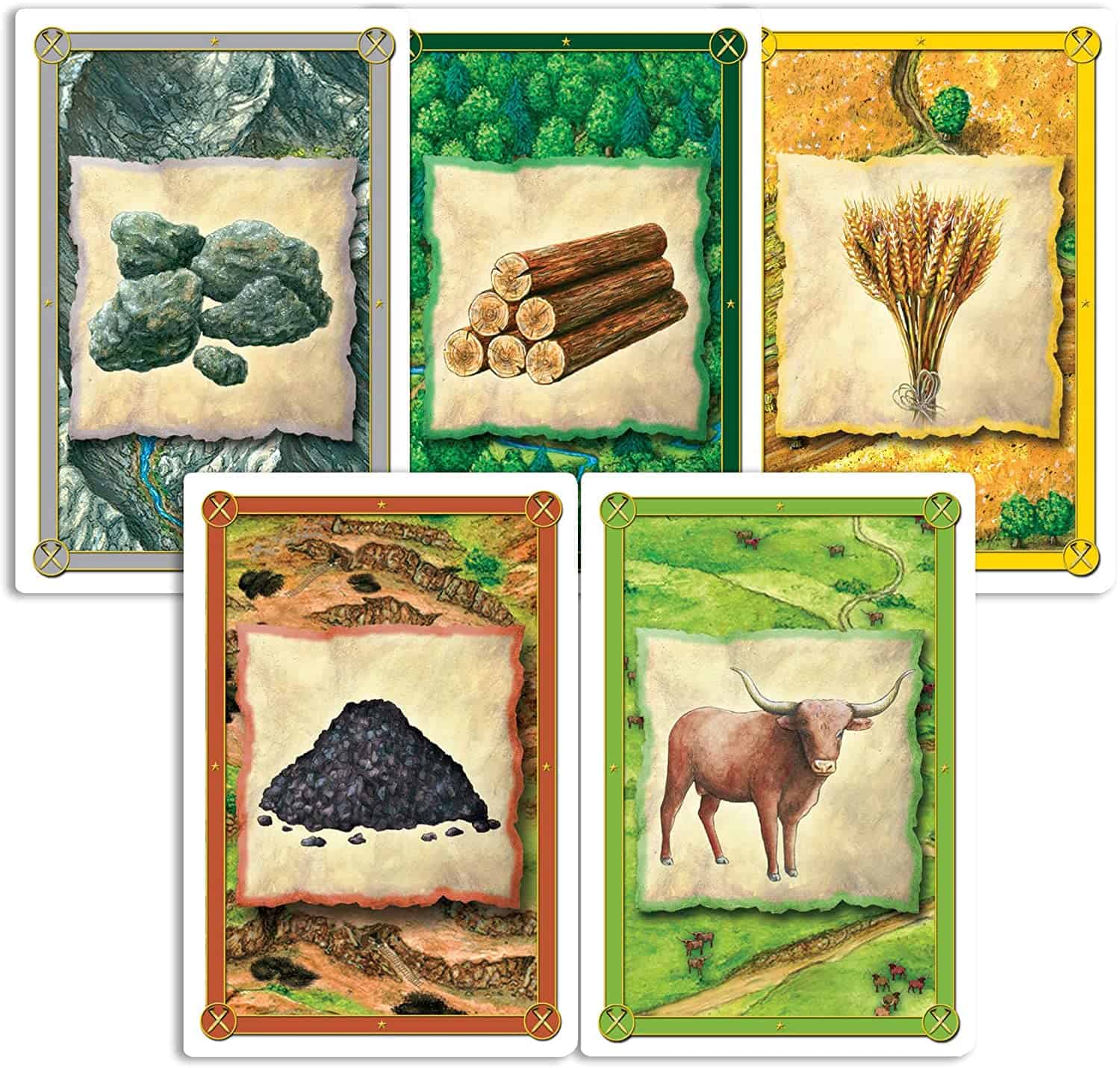
Providing the necessary conditions are satisfied, you can carry out any of these actions in any order:
- Trade with the supply or the other players
- Buy a development card
- Build a settler, a rail, or a train
- Move a settler and transform it into a city
- Move a train and deliver goods
- Play a development card
1. Trading
- Trade with opponents: You can trade resources and gold with other players. You can make offers and counteroffers or listen to your opponent’s offer.
- Buy a resource: You can do this using gold. For two gold, you can buy one resource.
- Exchange resources: Return three resource cards to the supply and take one gold or one resource card of your choice.
2. Buy Development Cards and Build
To buy a development card or build a settler, you have to exchange a certain amount of resource cards. You can build as often you want during your turn as long as you can afford it.
- Development card requires: 1 cattle, 1 coal: Return these resources to the supply to take the card.
- Settler requires: 1 cattle, 1 grain, 1 lumber: Return these and place your newly built settler next to any of your cities.
- Train requires: 1 ore, 1 lumber, 1 coal: Your newly built train has to be positioned next to one of your rails that is adjacent to one of your cities.
- Rail requires: 1 ore, 1 lumber: Place your newly built rail on a path that doesn’t already have one. This path must be adjacent to one of your cities and/or one of your rails.
Rails also produce gold in certain situations. For example, if you build a rail and an isolated city site becomes connected to another city site for the first time, you and potentially other players may earn gold as a result.
To work out who earns what, determine the shortest route between the two newly connected cities, and players receive one gold token for each rail of theirs that makes up the connection.
3. Move a Settler and Build a City
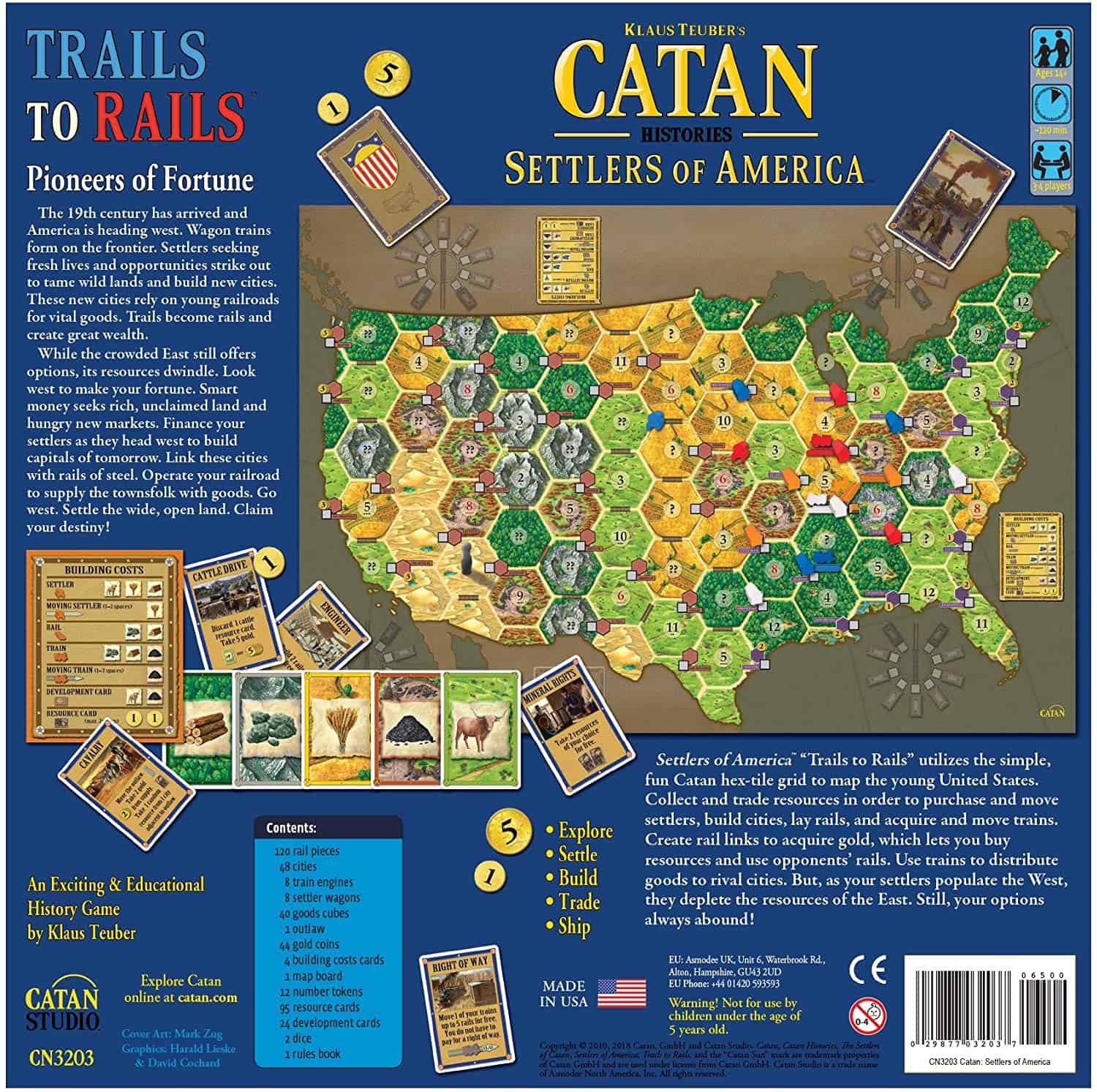
Move your settlers from intersection to intersection according to the following rules:
- You cannot move your settler to an intersection that is already occupied
- You don’t have to move your settler the full distance allowed by the total grain you pay
- You can’t split the movement paid for by your grain between two settlers
If one of your settlers lands on an empty city site, immediately replace it with a city. Return the settler and swap it for a city from your turntable. Here are some other things to be aware of:
- When you build a city, move the goods piece that was adjacent to the city on your turntable into the circle at the center – it’s now available for delivery
- Building a city on the coast means you earn gold in the amount indicated by the symbol next to the site
- If a newly built city is adjacent to a terrain hex marked with double question marks, move a number token already on the map board to that terrain hex
4. Play Development Cards
You can only play one development card during your turn. You can do this during the production phase before rolling the dice or at any moment during the action phase.
However, it’s important to note that you can’t play a development card on the same turn you buy it.
Follow the directions given in the card’s text before discarding it.
5. Move Trains and Deliver Goods
You can move trains from rail to rail (path to path); for each coal, you return to the supply you can move just one of your trains a distance of up to three rails.
- After a train’s movement, two trains at most can occupy the same path (one to the left and one to the right)
- You can’t split the movement from one coal between two trains
- If you move onto or through another player’s rails during your turn, you must pay that player a fee of one gold token
- At any time during your turn, if your train is adjacent to another player’s city, you can deliver one of your goods cubes
Extraordinary Build Phase

Starting with the player on your left and continuing clockwise, each player can build or buy:
- Settlers
- Trains
- Rails
- Development cards
During this phase of the game, players are not permitted to trade, play development cards, deliver goods, or move trains or settlers.
Winning the Game
When you have delivered all of your goods cubes, you win, and the game is over.
Who is Catan Settlers of America for?
Catan Settlers of America is intended for three to four players aged twelve and above.
It’s one of those excellent board games that can be recommended to people of all ages and backgrounds – such is Catan’s wide-ranging and enduring appeal. Settlers of America is no different to its original predecessor in this respect; in fact, in some ways it’s even better thanks to its ability to teach players about vital aspects of American history.
Not only would I say that Catan Settlers of America is a family game, I’d go as far as to propose that it’s actually one of the best family games on the market.
Naturally, it has a bigger appeal to history buffs, but the game itself is so enjoyable (and addictive) that this is by no means the only demographic who should try the game.
How Many Pieces are there in Catan Settlers of America?
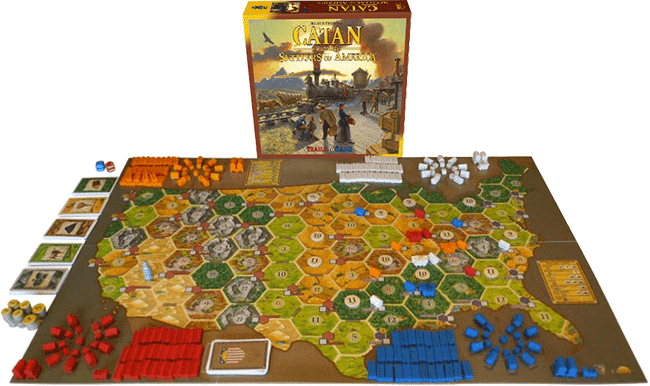
These components are all included in the game:
- Map board
- 4x sets of wooden game pieces (containing 30 rails, 12 cities, 2 trains, 2 settlers, and 10 goods)
- 12x number tokens
- 24x development cards
- 95x resource cards
- 4x building costs cards
- 1x outlaw piece
- 44x gold tokens (10 large, 34 small)
Alternatives to Catan Settlers of America
Here are some other games you might enjoy.
Ticket to Ride 1910

Do you love the historical element of Settlers of America? If so, I have the perfect game for you: Ticket to Ride 1910. This expansion pack takes the classic train-themed board game to a whole new level with 35 unique 1910 destination tickets.
Want to find out more? Check out our Ticket to Ride 1910 guide.
- Players – 2-5
- Recommended age – 8+
- Playing time – 30-60 minutes
Stratego Waterloo

Continuing with the historical theme, Stratego Waterloo is my next recommendation. It recreates the action of a real historic battle on the game board, allowing you to bring the cavalry into your very own living room. This highly tactical strategic game isn’t one to miss!
For all the information you need and more, read our Stratego Waterloo guide.
- Players – 2
- Recommended age – 12+
- Playing time – 45-120 minutes
Frequently Asked Questions
Question: Can You Play Catan Settlers of America Solo?
Answer: It definitely isn’t possible to play Settlers of America with just one person, but there are plenty of board games out there that do allow you to play solo. For more information, check out our guide to the best solo board games.
Question: Is Catan Settlers of America Suitable for Ten Year Olds?
Answer: Although the game is recommended for children aged twelve years and over, I believe some ten year olds would be able to play and enjoy the game. Nevertheless, it’s worth noting that there is a junior version of Catan, which you can read about.
Question: How Often do Terrain Hexes Produce?
Answer: The numbers on the terrain hexes all have different probabilities of being rolled. Out of thirty-six dice rolls:
• 6 and 8 come up roughly 5 times each
• 5 and 9 come up roughly 4 times each
• 4 and 10 come up roughly 3 times each
• 3 and 11 come up roughly 2 times each
Recommended reads:
Catan Settlers of America – is it Worth Buying?
Settlers of America is a game that I genuinely love playing, so on that basis, of course I would recommend it. However, does it do enough to make it worthwhile purchasing a whole new game if you already have the original Catan? That’s where things get a little more complicated.
There are lots of similarities with the original game, so if you’re trying Catan for the first time and you don’t have a particular interest in this period of American history, I would suggest buying the original instead of this spin-off.
However, taking the game as it is and excluding the numerous other versions of Catan that are out there, I definitely think Settlers of America is worth having on your shelf – especially if you have children and often host family game nights.
- Stratego Pieces Explained – Must-Know Facts - February 28, 2023
- Wahoo Board Game Guide – AKA Aggravation Guide - February 22, 2023
- Pokemon Monopoly Guide - February 22, 2023

